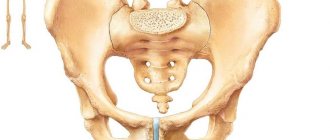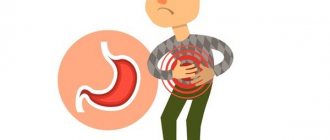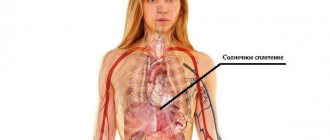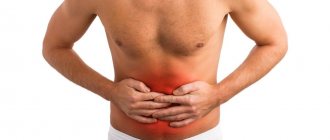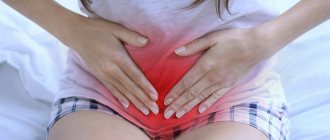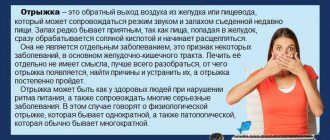Why does my stomach hurt when I press it?
Acute gastritis is one of the causes of pain when pressing on the lower abdomen. Additional symptoms of the disease include nausea, vomiting and frustration. In this case, the tongue may be covered with a grayish coating, salivation increases, or severe dryness develops in the oral cavity. However, before taking medications for gastritis, make sure the diagnosis is accurate, which must be confirmed by your doctor.
With appendicitis, pain appears when pressing on the lower abdomen on the right. When the pressure is relieved, the pain intensifies. The disease is accompanied by an increase in body temperature, increased heart rate, dry mouth, vomiting and nausea. If you have appendicitis, you should immediately consult a doctor.
When pressing on the stomach, pain in the abdominal cavity may be associated with diseases of the pancreas or liver. If the liver hurts and you feel sick, the cause may be cholecystitis, obesity, excessive physical activity the day before, or poisoning. In some cases, the stomach hurts when pressed due to inflammation of the duodenum. Only an experienced doctor can establish an accurate diagnosis and prescribe treatment.
Pain when pressing on the abdomen in the navel area is a sign of inflammation of the small intestine due to fermentation of undigested food, which provokes irritation of the mucous membrane. The pain may also be caused by excessive consumption of sugary foods or legumes, which cause flatulence.
Pain when pressing on the abdomen in the upper left is more common than on the right. This can be caused by an increase in the size of the spleen. During the examination, the doctor presses on this area of the abdomen, but lightly, so as not to cause rupture of the internal organ. Additionally, a symptom such as blueness of the skin surrounding the navel appears.
In women, the cause of pain in the abdominal cavity can be gynecological diseases. If urination becomes more frequent, pain and burning sensations appear, and the urine becomes cloudy, the problem may be due to problems in the functioning of the kidneys and urinary tract.
Causes of pain
Pain in the lower abdomen can indicate both physiological disorders and the development of serious diseases that can be very dangerous for a person. Therefore, every layman should know the methods of primary diagnosis. Often pain in the lower abdomen is a sign of the development of gastritis. This is the name for inflammation of the gastric mucosa, which interferes with the regeneration process. This is a violation that can lead to serious complications. In addition, this disease disrupts secretory function, which can also be very dangerous. You can determine whether gastritis is the cause of pain in the lower abdomen by the accompanying symptoms. These include signs such as:
- feeling of nausea and vomiting;
- constant heartburn;
- feeling of heaviness in the stomach;
- an unpleasant taste in the mouth that does not go away over time;
- general feeling of weakness.
You should not hope that the pain will go away on its own. Remember that gastritis is dangerous due to complications that require serious and long-term treatment.
How to get rid of abdominal pain when pressing
It is not recommended to self-treat abdominal pain with pressure. Many people prescribe analgesics to themselves. However, such self-treatment of abdominal pain when pressed does not cure the disease, but only relieves the symptoms for a while, but can also aggravate the disease by irritating the mucous membranes.
The only thing that doctors recommend doing for abdominal pain when pressed at home is to completely exclude everything spicy, salty, fried, coffee and strong tea from your diet. Doctors prescribe appropriate treatment after diagnosis, which may be based on taking certain medications.
Mineral water containing alkali and having a salty taste can relieve pain. You should drink plenty of liquid, often and in small sips.
When pain is caused by inflammation of the gallbladder, pancreatitis, cholecystitis, stomach or duodenal ulcer, the doctor may prescribe No-shpa to relieve pain. Dallak, Trigan and Galidor are also sometimes used. For non-acute forms of illness, before the doctor arrives, you can take the choleretic drug Hologon, Allochol or Olimethin.
For pain in the abdominal cavity due to an ulcer, doctors prescribe Almagel, constant consumption of warm mineral water, as well as some medications prescribed taking into account the characteristics of the disease.
If you are struck by an acute attack of hepatic colic, put Nitroglycerin under your tongue and take a couple of tablets of No-shpa, Dollak or Trigan. When the pain when pressing on the abdomen is localized below, take a painkiller - Baralgin or Analgin, and then consult a doctor.
Timely diagnosis is a chance to prevent negative consequences
The doctor palpates different areas of the patient's abdomen.
A doctor, examining a patient with complaints of abdominal pain, palpates different areas. During the interview, it is necessary to identify additional symptoms, how and when the first pain sensations occurred, what provokes the pain. Assuming a diagnosis, the following examination methods are additionally prescribed:
- X-ray of the abdominal organs;
- computed tomography of the digestive organs;
- general blood analysis.
What is belly?
The abdomen is the part of the torso that is located between the diaphragm and the pelvis. This is where a significant part of the gastrointestinal tract is located, therefore including the stomach, duodenum, small and large intestines, as well as the liver, pancreas and gall bladder.
The abdomen also contains the urinary system, which consists of the kidneys, bladder and urethra, which carries urine out, as well as part of the female reproductive system: the ovaries, fallopian tubes, and uterus.
Since all these organs must be muscular, supplied with blood and have sufficient innervation, there is therefore a network of blood vessels and nerves in the abdomen, in particular the abdominal aorta, the main inferior vein and the vagus nerve.
Features of pain on palpation
The process of palpation of the stomach and intestines is important in terms of diagnostic examination of the human body. Monitoring of the digestive organs is carried out as follows: at the first stage, a qualified specialist carefully palpates the sigmoid colon - this is the most common landmark and the most accessible organ for palpation. Next, the doctor proceeds to study the condition of the cecum and transverse colon. The ascending and descending sections of the suction organ are quite problematic to palpate.
In practice, during palpation, fingers must be carefully immersed on the surface of the body area and gently pressed onto the organ being examined (toward the posterior abdominal wall). Using sliding movements, you can clearly determine the contours, density, and the presence of various neoplasms and abnormalities. When you touch (feel) the sigmoid colon, you get the impression that there is a smooth, dense and mobile cylinder in the human body. The size of such a “geometric figure” does not exceed the thickness of a person’s thumb. The formation parameters are directly related to the condition of the walls, which are densely filled with gases and decay products (feces/feces).
During the inflammatory process of the infiltrating walls, a significant thickening of the membrane occurs. Ulcerative manifestations form a lumpy and uneven surface of the suction organ. Acute inflammation of the sigmoid colon is accompanied by the formation of a dense consistency of painful manifestation. Due to the dense overflow of gases and liquid contents, motor inhibition occurs. The spasm is felt in the form of a cord and cord. The patient experiences systematic rumbling + false urge to defecate (false diarrhea).
In normal condition, the cecum is easily palpable. A specialist can detect a cylinder up to 3 cm that is moderately active in movements. Its mobility in a pathological disorder is significantly increased. The internal consistency becomes significantly thicker during coprostasis and chronic inflammation. The volume and shape of the cecum directly correlates with the contents. In a normal functional state, the intestines do not growl.
The patient should remember that the presence of pain upon palpation in the area of the cecum indicates the development of a pathological process. The digestive organ requires systematic and comprehensive treatment.
In practice, after examining the cecum (+ appendix), it is possible to examine the less accessible parts of the large intestine. Palpation is carried out from the ascending to the transverse colon and descending colon. The transverse colon part of the suction organ can be qualitatively palpated only in the case of chronic inflammation. Tone, consistency, volume, shape depend on the tone and degree of muscle tension. For example, an inflammatory process of the ulcerative type forms serious preconditions for the transformation of the transverse colon. At the same time, the muscles of the organ thicken significantly, and its configuration changes.
Today, chronic colitis and percolitis are quite common. With these ailments, the wall of the suction organ begins to painfully contract. Due to the lumpy surface, palpation is accompanied by sharp pain. For example, with pericolitis, respiratory and active mobility is lost.
Palpation of the abdomen allows you to feel an intestinal tumor, which is often confused with the pathology of various organs. Oncology of the cecum and transverse colon is distinguished by already known mobility. The pain is activated during the act of breathing (tumors below the navel are motionless). Palpation of the abdomen during enterocolitis is accompanied by rumbling in the navel area. The disease has specific signs and symptoms: painful diarrhea (mushy, mucous stools, abdominal pain, hard colon). Palpation of the abdomen is carried out in combination with a digital examination of the rectum (sigmoidoscopy + radiography). These actions make it possible to predict the formation of rectal cancer and the formation of various syphilitic structures. It will also be possible to clearly determine the presence of inflammatory processes, cracks, fistulas, hemorrhoids and all kinds of tumors. The specialist can get a clear vision of the sphincter tone and the level of filling of the colon ampulla. In some cases, it is rational to palpate adjacent organs (bottom of the bladder, prostate gland, uterus with appendages). This will reveal an ovarian cyst, a tumor of the genital organs, the degree of constipation, etc.
Diagnostics
Anyone with severe abdominal pain should call 911 and be seen by a doctor immediately.
The attending physician will need to examine the patient and gently press on various areas of the abdomen. People with peritonitis often have tense abdominal muscles in the affected area.
The doctor should note a tender point - this is a general term that means that the patient has increased pain sensitivity in a certain area of the abdomen.
For example, if a patient has appendicitis, he will likely have tender points when a certain part of his abdomen is touched (McBurney's sign).
The doctor may also ask the patient questions about his symptoms and medical history:
– when the symptoms began; – Is this the first time the patient has had such discomfort; – when discomfort typically occurs; – what other symptoms does the patient have – for example: constipation; diarrhea; fainting; heat; vomit.
The following diagnostic measures can be done:
– X-ray of the abdominal cavity (peritoneum); – CT scan of the abdominal cavity (peritoneum – sometimes); – blood test – general or differential.
In some cases, immediate surgery will be necessary: exploratory laparotomy or appendectomy.
Etiology and elements of the pathogenesis of pain
According to the teachings about the physiological components of pain, it is considered as irritation of receptors in the serous membrane, skin, and muscles. It is provoked by an inflammatory process or lack of blood supply, obstruction of patency in the cavities, sudden stretching or, conversely, narrowing of the organ.
The reasons why the stomach may hurt when pressed may be the following:
- Inflammatory process in the organs of the digestive system: gastritis, pancreatitis, cholecystitis, hepatitis, colitis.
- Appendicitis, urinary tract infections, ulcers complicated by perforation, bleeding, acute intoxication due to pancreatitis.
- Mechanical narrowing of the bile-urinary ducts.
- Thrombosis of organs and blood vessels.
- Mechanical trauma to the peritoneum.
- Violation of intestinal digestion and absorption of food.
- Gynecological inflammatory diseases.
- Intestinal adhesions after surgery.

